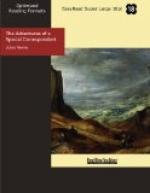The completed portion gives me direct communication across Central Asia. That is the main line of the Transasiatic. The engineers did not find it so difficult of construction as General Annenkof did the Transcaspian. The deserts of Kara Koum and Gobi are very much alike; the same dead level, the same absence of elevations and depressions, the same suitability for the iron road. If the engineers had had to attack the enormous chain of the Kuen Lun, Nan Chan, Amie, Gangar Oola, which forms the frontier of Tibet, the obstacles would have been such that it would have taken a century to surmount them. But on a flat, sandy plain the railway could be rapidly pushed on up to Lan Tcheou, like a long Decauville of three thousand kilometres.
It is only in the vicinity of this city that the art of the engineer has had a serious struggle with nature in the costly and troublesome road through the provinces of Kan-Sou, Chan-Si and Petchili.
As we go along I must mention a few of the principal stations at which the train stops to take in coal and water. On the right-hand side the eye never tires of the distant horizon of mountains which bounds the tableland of Tibet to the north. On the left the view is over the interminable steppes of the Gobi. The combination of these territories constitutes the Chinese Empire if not China proper, and we shall only reach that when we are in the neighborhood of Lan Tcheou.
It would seem, therefore, as though the second part of the journey would be rather uninteresting, unless we are favored with a few startling incidents. But it seems to me that we are certainly in the possession of the elements out of which something journalistic can be made.
At eleven o’clock the train left Kothan station, and it was nearly two o’clock in the afternoon when it reached Keria, having left behind the small stations of Urang, Langar, Pola and Tschiria.
In 1889-90 this road was followed by Pevtsoff from Kothan to Lob-Nor at the foot of the Kuen Lun, which divides Chinese Turkestan from Tibet. The Russian traveler went by Keria, Nia, Tchertchen, as we are doing so easily, but then his caravan had to contend with much danger and difficulty—which did not prevent his reporting ten thousand kilometres of surveys, without reckoning altitude and longitude observations of the geographical points. It is an honor for the Russian government to have thus continued the work of Prjevalsky.
From Keria station you can see to the southwest the heights of Kara Korum and the peak of Dapsang, to which different geographers assign a height of eight thousand metres. At its foot extends the province of Kachmir. There the Indus rises in a number of inconsiderable sources which feed one of the greatest rivers of the Peninsula. Thence from the Pamir tableland extends the mighty range of the Himalaya, where rise the highest summits on the face of the globe.
Since we left Kothan we have covered a hundred and fifty kilometres in four hours. It is not a high rate of speed, but we cannot expect on this part of the Transasiatic the same rate of traveling we experienced on the Transcaspian. Either the Chinese engines are not so fast, or, thanks to their natural indolence, the engine drivers imagine that from thirty to forty miles an hour is the maximum that can be obtained on the railways of the Celestial Empire.




